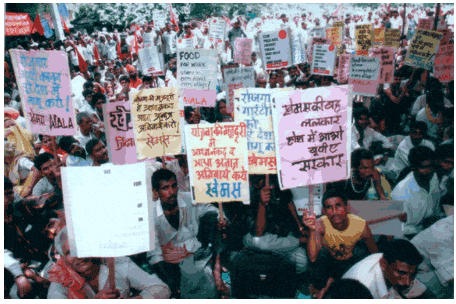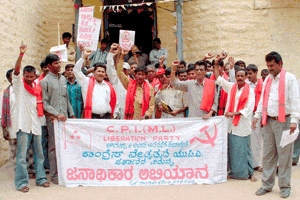

Two years after coming to power, the UPA Govt. found every one of its moves subjected to public scrutiny, every betrayal, every vacillation challenged by people, in a spirited Janadhikar Abhiyan called by the CPI(ML) between August 6-18. The campaign was remarkable for its wide reach – as intense in remote corners of the country and rural countryside as in the cities and capitals – and its militant mass mobilisation.
Defending Sovereignty and Security, Resisting Imperialism
The Janadhikar Abhiyan was launched on August 6, (Hiroshima Day), with the US-backed Israeli war on Lebanon and the Indo-US Nuclear Deal back home giving an urgent edge to the popular protests. At the State capitals of Lucknow, Ranchi, Patna, Guwahati, Jaipur, Kolkata, and Delhi, protest marches and conventions were held, as also in several centres in UP, Bihar, Jharkhand, Punjab, Tripura, Assam, Rajasthan, Haryana, Uttaranchal, Tamil Nadu, Andhra Pradesh, Orissa, Pondicherry, and West Bengal. A massive Convention against US Imperialism was organised by the Inquilabi Muslim Conference at Rajdhanwar in Giridih – which was addressed by the CPI(ML) General Secretary Dipankar Bhattacharya. Students held protests in many campuses too; AISA burnt the effigy of Bush and Olmert outside Banaras Hindu University, and in JNU, AISA organised Poetry Readings Against Imperialism followed by a screening of the film Avenge But One of My Two Eyes by a noted Israeli filmmaker, which was attended by a large number of students. Protest meetings were also organised at Harapanahalli in Davanagere district of Karnataka and Tirunelveli in Tamil Nadu.
On August 9, Quit India Day, once again protests were held with students and youth at the forefront. RYA burnt the effigy of PM Manmohan Singh at Ranchi in protest against the UPA Government's pro-imperialist policies; and AISA in Assam held a state-level convention at Guwahati. Even as the Indian Parliament was disgracing itself with its silence on the bombing in Lebanon, and was arriving at a ‘consensus' to support the Indo-US Nuclear Deal, people at the Janadhikar protests were demanding the scrapping of the Indo-US Nuclear Deal, an end to the war in Lebanon and a firm position by the Government of India against racist Israel. They were pointing out that the servility of successive Indian Governments to the US was not only eroding our sovereignty, it was also compromising India 's security.
Agrarian Labour Lead the Struggle Against Price Hikes, Dismantling of PDS, and Subverting of NREGA
 At a time when tribals and agrarian poor suffer the worst brunt of starvation and unemployment, and are worst hit by the hikes in prices of essential commodities and the simultaneous dismantling of the PDS, agrarian labourers raised a war cry against the UPA Government at the Centre, and State Governments too. At the same time, they also protested against the attempt to rob the Right to Information Act of its essence; and exposed the reality of the National Rural Employment Guarantee Act at the grassroots.
At a time when tribals and agrarian poor suffer the worst brunt of starvation and unemployment, and are worst hit by the hikes in prices of essential commodities and the simultaneous dismantling of the PDS, agrarian labourers raised a war cry against the UPA Government at the Centre, and State Governments too. At the same time, they also protested against the attempt to rob the Right to Information Act of its essence; and exposed the reality of the National Rural Employment Guarantee Act at the grassroots.
Most remarkable was the sheer enthusiasm with which agrarian labourers entered into the campaign even in the most backward regions and rural hinterlands. One high point of the campaign was August 10, when agrarian strike and protest demonstrations were organised by the AIALA at 172 blocks spread over 29 districts of Bihar with mass participation ranging from 500 to 3,000. Similar demonstrations were held in several districts in UP as well. On August 14, protests were organised by JHAMKIS at over 100 blocks in Jharkhand. Protests were also organised in other states like Tamil Nadu, Andhra Pradesh , Assam , West Bengal , Tripura, Rajasthan, and Orissa. In particular, the tribal people of the hill districts of Karbi Anglong and North Cachhar Hills in Assam , and the tea workers of Assam 's plantations, played a very assertive role in the campaign.
Scams in the PDS system, Antyodaya scheme, NFFW, and the NREGA were subjected to a ruthless popular exposure, and local block and district HQs became the targets for determined protests by the rural poor protesting against the corruption and callousness in implementing development and welfare schemes.
In a way, this aspect of the campaign was a mass exercise in public democracy; a sort of mass assertion of the Right to Information, and the right to monitor the implementation of development schemes and make accountable the functioning of elected panchayat representatives. This campaign culminated in the Jan Sunwai on NREGA at Jantar Mantar on August 17 (detailed report follows).
For Democracy, For the Right to Education and Employment for All
In every state, an important aspect of the Janadhikar Campaign was against the crackdown on democracy and social justice. In Jharkhand, the entire campaign protested against the systematic witch-hunt against political activists who work amongst the poor, and against the virtual police raj in the state. Jharkhand, Chhattisgarh, Bihar , UP, were identified as a sort of belt of state terror, where the nexus between feudal private armies, the state, and criminal mafia gangs has become inextricable. In Bihar , agrarian labourers everywhere made the dismantling of the Amir Das Commission by the Nitish Government, and the growing assaults on agrarian poor, a major political issue.
The culminating point of the Janadhikar Campaign was the massive Student-Youth March to Parliament, in which students and youth from all over the country marched to protest against the UPA Government's scuttling of the Right to Education Bill, the betrayal of the promise to introduce a Common School System and Universal Employment Guarantee, and the dilutions and delays in the introduction of 27% OBC quota and 54% increase in seats in higher education. This massive AISA-RYA March ended in a Public Meeting at Jantar Mantar which was addressed by CPI(ML) General Secretary Dipankar Bhattacharya and Polit Bureau member Akhilendra Pratap Singh. The Campaign ended with a rousing challenge to the UPA for selling out India 's sovereignty and the interests of India 's working poor, and a call to intensify the protests and organise a befitting celebration of the oncoming Birth Centenary Year of Bhagat Singh throughout the country.